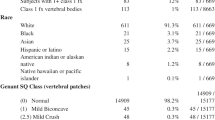Abstract
Osteoporotic vertebral fractures have a severe impact on patients’ overall well-being but are severely under-diagnosed. These fractures present themselves at various levels of severity measured using the Genant’s grading scale. Insufficient annotated datasets, severe data-imbalance, and minor difference in appearances between fractured and healthy vertebrae make naive classification approaches result in poor discriminatory performance. Addressing this, we propose a representation learning-inspired approach for automated vertebral fracture detection, aimed at learning latent representations efficient for fracture detection. Building on state-of-art metric losses, we present a novel Grading Loss for learning representations that respect Genant’s fracture grading scheme. On a publicly available spine dataset, the proposed loss function achieves a fracture detection F1 score of 81.5%, a 10% increase over a naive classification baseline.
M. Husseini and A. Sekuboyina—Shared first authors.
Access this chapter
Tax calculation will be finalised at checkout
Purchases are for personal use only
Similar content being viewed by others
References
Genant, H.K., et al.: Vertebral fracture assessment using a semiquantitative technique. J. Bone Miner. Res. 8(9), 1137–1148 (1993)
Carberry, G., et al.: Unreported vertebral body compression fractures at abdominal multidetector CT. Radiology 268(1), 120–126 (2013)
Cauley, J., et al.: Risk of mortality following clinical fractures. Osteoporos. Int. 11(7), 556–561 (2000)
Loeffler, M., et al.: A vertebral segmentation dataset with fracture grading. Radiol. Artif. Intell. 2(4), e190138 (2020)
Sekuboyina, A. et al.: VerSe: A Vertebrae Labelling and Segmentation Benchmark. arXiv eprint: 2001.09193. arXiv preprint arXiv:2001.09193 (2020)
Sekuboyina, A., et al.: Labelling vertebrae with 2D reformations of multidetector CT images: an adversarial approach for incorporating prior knowledge of spine anatomy. Radiol. Artif. Intell. 2(2), e190074 (2020). https://doi.org/10.1148/ryai.2020190074
Valentinitsch, A.: Opportunistic osteoporosis screening in multi-detector CT images via local classification of textures. Osteoporos. Int. 30(6), 1275–1285 (2019). https://doi.org/10.1007/s00198-019-04910-1
Bar, A., et al.: Compression fractures detection on CT. In: Medical Imaging 2017: Computer-Aided Diagnosis, vol. 10134, p. 1013440. International Society for Optics and Photonics (2017)
Tomita, N., et al.: Deep neural networks for automatic detection of osteoporotic vertebral fractures on CT scans. Comput. Biol. Med. 98, 8–15 (2018)
Nicolaes, J. et al.: Detection of vertebral fractures in CT using 3D Convolutional Neural Networks. arXiv preprint arXiv:1911.01816 (2019)
Chen, W., et al.: Beyond triplet loss: a deep quadruplet network for person re-identification. In: Proceedings of the IEEE Conference on Computer Vision and Pattern Recognition, pp. 403–412 (2017)
Husseini, M., Sekuboyina, A., Bayat, A., Menze, B.H., Loeffler, M., Kirschke, J.S.: Conditioned variational auto-encoder for detecting osteoporotic vertebral fractures. In: Cai, Y., Wang, L., Audette, M., Zheng, G., Li, S. (eds.) CSI 2019. LNCS, vol. 11963, pp. 29–38. Springer, Cham (2020). https://doi.org/10.1007/978-3-030-39752-4_3
Raghu, M., et al.: Transfusion: understanding transfer learning for medical imaging. Adv. Neural Inf. Process. Syst. 10(10007/1234567890), 3342–3352 (2019)
Schroff, F., et al.: FaceNet: a unified embedding for face recognition and clustering. In: Proceedings of the IEEE Conference on Computer Vision and Pattern Recognition, pp. 815–823 (2015)
Hadsell, R., et al.: Dimensionality reduction by learning an invariant mapping. In: IEEE Computer Society Conference on Computer Vision and Pattern Recognition, vol. 2, pp. 1735–1742 (2006)
Finn, C., et al.: Model-agnostic meta-learning for fast adaptation of deep networks. In: Proceedings of the 34th International Conference on Machine Learning, vol. 70, pp. 1126–1135 (2017)
Acknowledgements
This work is supported by DIFUTURE, funded by the German Federal Ministry of Education and Research under (01ZZ1603[A-D]) and (01ZZ1804[A-I]).
Author information
Authors and Affiliations
Corresponding author
Editor information
Editors and Affiliations
1 Electronic supplementary material
Below is the link to the electronic supplementary material.
Rights and permissions
Copyright information
© 2020 Springer Nature Switzerland AG
About this paper
Cite this paper
Husseini, M., Sekuboyina, A., Loeffler, M., Navarro, F., Menze, B.H., Kirschke, J.S. (2020). Grading Loss: A Fracture Grade-Based Metric Loss for Vertebral Fracture Detection. In: Martel, A.L., et al. Medical Image Computing and Computer Assisted Intervention – MICCAI 2020. MICCAI 2020. Lecture Notes in Computer Science(), vol 12266. Springer, Cham. https://doi.org/10.1007/978-3-030-59725-2_71
Download citation
DOI: https://doi.org/10.1007/978-3-030-59725-2_71
Published:
Publisher Name: Springer, Cham
Print ISBN: 978-3-030-59724-5
Online ISBN: 978-3-030-59725-2
eBook Packages: Computer ScienceComputer Science (R0)





